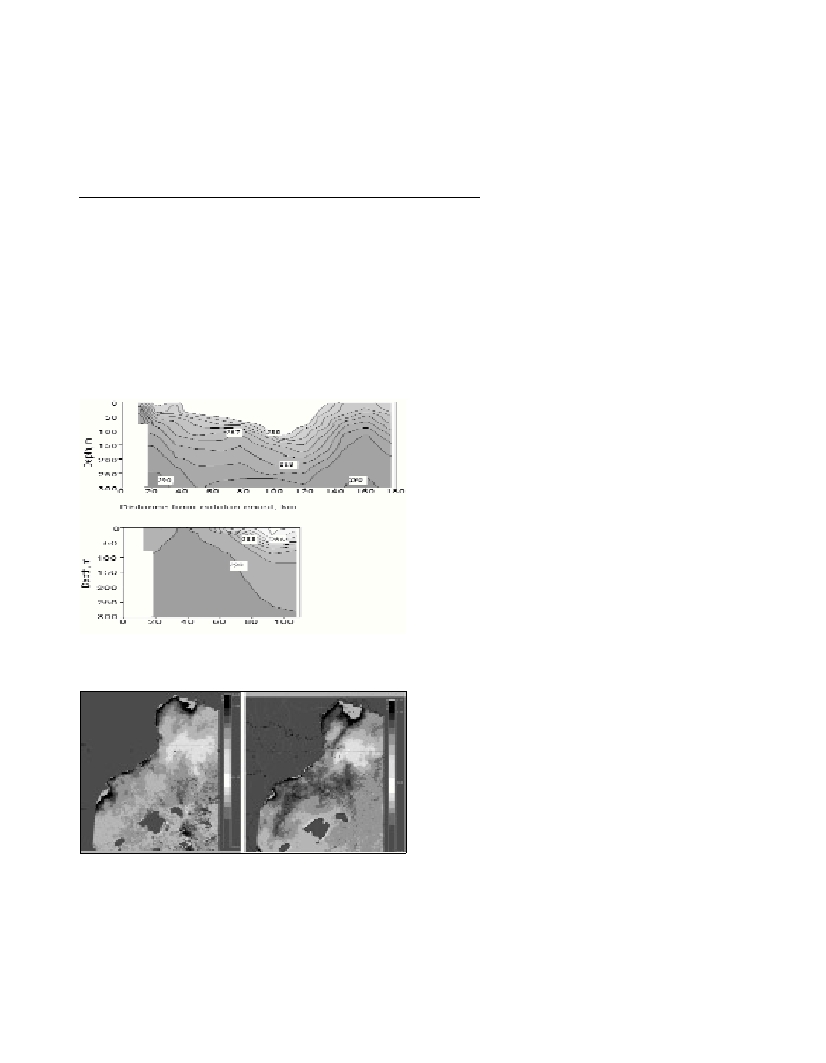Rapp. Comm. int. Mer Médit., 37,2004
96
IMPLICATIONS OF A WINTER CIRCULATION ANOMALY IN THE CATALANO-BALEARIC SEA FOR
DEEP MIXING AND PHYTOPLANKTON DISTRIBUTIONS.
M. Estrada, J. Salat*, M. Emelianov, L. Arín, D. Blasco, A. Morales
ICM-CSIC. P. Marítim, 37. 08003 Barcelona. Spain - marta@icm.csic.es
Abstract
The reduction of deep mixing extent and changes in phytoplankton distributions due to an anomaly in the circulation during winter are
presented and compared with a typical winter.
Keywords: Deep mixing, phytoplankton, NW Mediterranean, marine circulation
Introduction
Deep mixing is a well known feature occurring at open sea in the
Northwestern Mediterranean during winter. After the strong mixing
pulses once the ocean is stratifying again there is an important spring
phytoplankton bloom which is using the nutrient enrichment at the
photic level. The extent and distribution of strong mixing is controlled
both by northerly winds and the current pattern. Usually the
circulation describes a cyclonic path with maximum current speeds
near the continental slopes. In the centre a typical doming of
isopycnals (1) which, under the typical winter conditions, is
preconditioning the surface waters for deep mixing that will be
triggered by strong northerlies. Only during very mild winters (2),
mixing might not get the deepest layers.
Fig. 1.Vertical sections of density across the Catalano-Balearic sea. Up:
winter 1999, Down: winter 2000
Fig. 2.Seawifs images of chlorophyll. Left: winter 1999, Right: winter 2000.
It has been agreed that the variability in the extent of the deep
mixing process is directly related to the “severity” of the winter and
the intensity and persistence of northerlies. This assumption however
impliclty includes that the variability of the circulation pattern in the
northern half of Western Mediterranean is relatively small or, at least,
it maintains its cyclonic tendency over all the northern basin.
Results and discussion
In winter 1999 a persistent anticyclonic eddy was detected in the
centre of the Catalano-Balearic sea (3). The classical doming of
isopycnals was then limited preventing the southern extent of deep
mixing process, even when the atmospheric conditions were suitable.
The water mass involved in this anticyclonic eddy was a relatively
new AW, with low surface salinity, instead of the classical old one
with higher salinity. Consequently the surface of the central part of the
Catalano-Balearic basin remained stratified during this winter. In
other words, it was impossible to reach the surface density values high
enough so that they become available for deep mixing. This anomaly
imposed a severe restriction to the deep mixing extent south of 42°N
and created a W-E frontal situation across the basin around this
parallel. As a result, the northern current was de?ected towards the
east and did not reach the southern half of the Catalan slope. It was
there replaced by a current from the south.
The biological distributions obtained from two oceanographic
winter cruises in the Catalano-Balearic sea (Winter 1999 and 2000),
carried out respectively under the anomalous and typical winter
conditions, reveal the effects of the anomaly both near the coast and
in open sea.
In 1999, high chlorophyll concentrations (chl_a), associated with
diatoms, developed in the northern part of the study area and very
close to the Catalan coast, while the anticyclonic eddy remained
dominated by haptophytes (including Phaeocystisand
coccolithophorids) and other ?agellates, and presented relatively low
chl_a concentrations. In winter 2000, elevated phytoplankton biomass
values could be also found in the central zone, including diatoms.
The subsequent development of the winter phytoplankton bloom, as
seen through SEAWIFSimages, also presented marked differences
between the winters of 1999 and 2000. From January to March, chl_a
in the whole Catalano-Balearic Sea appeared to be lower in 1999 than
in 2000. However in the northern part of the Western basin, chl_ain
1999 were much higher than in 2000 but the opposite happened in the
area to the West of the Balearic Islands. These chl_apatterns appear
to be linked to the presence of the anticyclonic eddy and its role
blocking the typical circulation pattern.
Both the changes in total phytoplankton biomass and the
dominance of different phytoplankton assemblages have ecological
consequences. Diatom dominance favours the so-called classical food
web (phytoplankton-mesozooplankton-fish), while small ?agellates
tend to enter the microbial food web. The reported observations
suggest that the presence of anticyclonic eddies like that registered in
1999 may have important biogeochemical implications in addition to
limiting the extent of deep mixing processes.
References
1-Font, J., Salat, J., Tintoré, J., 1988. permanent features of the
circulation in the Catalan sea. Oceanol. Acta, 11: 51-57.
2-Estrada, M., Varela, R. A., Salat, J., Cruzado, A., Arias, E., 1999.
Spatio-temporal variability of the winter phytoplankton distribution across
the Catalan and North Balearic fronts (NW Mediterranean). Journal of
Plankton Research, 21: 1-20.
3-Pascual, A., Nardelli, B. B., Larnicol, G., Emelianov, M., Gomis, D.,
2002. A case of an intense anticyclonic eddy in the Balearic Sea (western
Mediterranean). Journal of Geophysical Research, vol. 197, No. C11, doi:
10.1029/2001JCC000913.

